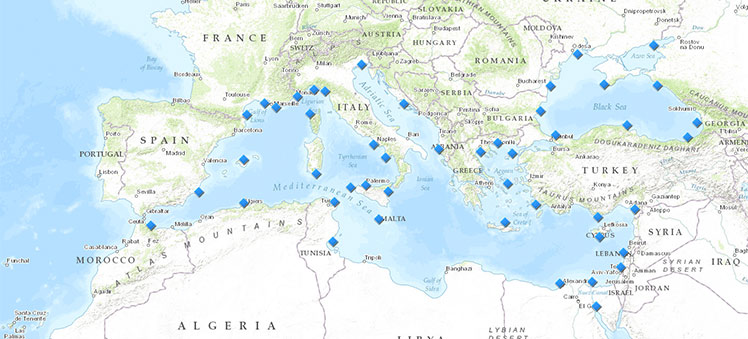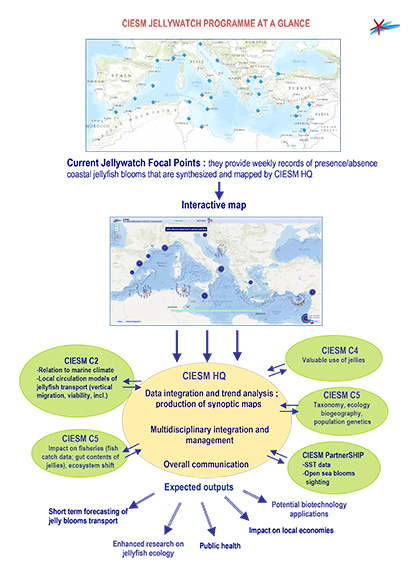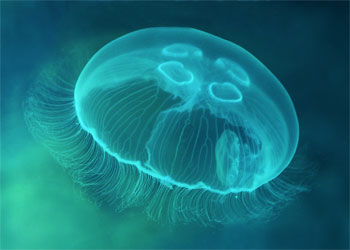CIESM JellyWatch Program
Monitoring jellyfish blooms along Mediterranean coasts
and in the open sea.
CIESM HQ support:
Annelyse Gastaldi
ACTIVE JELLYWATCH FOCAL POINTS

|
JELLYWATCH OPERATIONAL AREAS
- Algerian coast, Dr Nadira Ait-Ameur, ENSSMAL, Alger;
- Croatia, Dalmatian coast, Dr Davor Lučić, Inst. Marine & Coastal Research, Univ. Dubrovnik
- Cyprus, southern waters, Dr Yianna Samuel Roads, Univ. of Cyprus, Oceanographic center, Nicosia;
- France / Monaco, Cote d'Azur Annelyse Gastaldi, CIESM HeadQuarters;
- France, Golfe du Lion, Dr Delphine Thibault-Botha, MIO, Marseille;
- Greece, northern Crete, Dr. Costas Dounas, IMBBC, Heraklion w
- Greece, Cyclades, south Aegean, Dr Anastasia Miliou, Archipelagos Institute of Marine Conservation, Samos;
- Greece, Gulfs of Thermaikos and Kavala, northeast Aegean, Dr Thanassis Tsikliras
- Israel, Dr Bella Galil, IOLR, Haifa
- Italy, Gulf of Genoa, Prof Luigi Pane/ Dr Guido Bonello / Dr Gian Luigi Mariottini, Univ. di Genova/ DISTAV
- Italy, Cilento coast, Fabio Barbieri, Capo Palinuro
- Italy, Sicily, Palermo area, Dr. Benedetto Sirchia, ARPA, Palermo
- Italy, Sicily, Strait of Messina, Dr Letterio Guglielmo, Univ. Messina;
- Italy, Gulf of Trieste, Dr Roberto Odorico, AMP Miramare;
- Libya, Dr Daw A. Haddoud, Marine Biology Research Center, Tajura -Tripoli;
- Maltese waters, Dr Adriana Vella, Univ. of Malta;
- Maroc, nord-ouest, Dr Mustapha Aksissou, Dept of Biology, Faculty of Science, Tétouan;
- Spain, Baleares, Dr Salud Deudero, Centro Oceanografico de Baleares, IEO, Palma de Mallorca;
- Spain, southern waters, Dr Juan Eduardo Guillen, Litoral Ecology Institute, Alicante;
- Spain, Catalunya, Dr Veronica Fuentes, Institute of Marine Sciences, Barcelona (2011 - 2012);
- Tunisia, northern waters Dr Raouia Ghanem, INAT, Tunis.
- Tunisia, Gulf of Gabes Dr Jamila Ben Souissi, INAT, Tunis.
- Turkey, Istanbul Strait, Mss Deniz Taşkın, Tudav Foundation, Istanbul
- Turkey, Gökçeada island, northeast Aegean, Dr Onur Gönülal
- Turkey, Anatolian coast, central, Ms Destan Öztürk, Marine Science Institute, Erdemli
- Turkey, Anatolian coast, south east, Dr Cemal Turan, Mustafa Kemal University, Hatay;
|
|
|
|
BACKGROUND
While jellyfish are a natural feature of the Mediterranean Sea, “jelly blooms” were rare episodes until the last eight years, when massive swarms of gelatinous organisms became a frequent sight in coastal waters. Such events represent a nuisance for swimmers, and in the case of certain species may become a real health hazard. They are considered a pest by fishermen, as they clog nets, keep away fish and consume fish larvae. In recent years, a number of industrial marine cooling systems had to be put temporarily out of order as jellies clogged the underwater pipes. The resulting socio-economic impacts – both direct (tourism) and indirect (coastal development, fisheries) – are thus tangible. From an ecosystem perspective, the apparent increase and synchrony of jellyfish outbreaks in both western and eastern Mediterranean basins are sending warning signals of a potential phase shift from a fish to a “gelatinous sea". Although overfishing, coastal habitat degradation and climate warming are amongst the most probable drivers, the specific causes and mechanisms are not well identified, and the lack of reference data makes any further investigation difficult.

The CIESM Jelly Watch Program was set up to gather for the first time baseline data on the frequency and extent of jellyfish outbreaks across the Mediterranean Sea.
After a successfull pilot test phase involving a few countries, a common, standardized protocol including systematic recording of presence/absence data has been adopted for both coastal and open sea sightings of jellyfish swarms in the whole Basin, enabling an unbiased assessment of the geographic and temporal scale of these mass events so as to allow in time trend analysis and short term forecasting of jellyfish bloom transport.
|
PILOT PHASE (2008-2009), SETTING UP A CITIZEN-BASED SYSTEM FOR OPPORTUNISTIC OBSERVATIONS
In summer 2008, we initiated JellyWatch by launching a pilot, citizen-based study in Italian waters. A poster (see below) was broadly diffused to draw the attention of coastal users (fishermen, divers, tourists) but also ferry passengers, asking for their report of sightings of jellyfish swarms. The poster presents true-to-life drawings that illustrate the most common species of jellyfish found in the Mediterranean, along with a list of basic questions (formulated for the non-specialist observer) on the location, type and extension of the observed swarms.
The poster was successfully tested: records were sent by email to key scientists who acted as focal points in different regions. The media were heavily involved in the campaign, from televisions, newspapers and magazines. The massive presence of jellyfish during 2009 - when Israel was added to the pilot phase with equal success (lead: Dr Bella Galil) - enhanced the value of the initiative, and hundreds of records, documented by photographs, have been received. Medusa blooms have been documented as never before. |
|
|
GEOGRAPHIC AND THEMATIC EXTENSION – FROM CITIZEN SCIENCE TO MULTIDISCIPLINARY SCIENCE
The extension to the whole Mediterranean is progressing in a stepwise fashion. A special technical meeting organised during the 39th CIESM International Congress in Venice (10-14 May 2010) assembled interested scientists from a variety of concerned countries. The CIESM Jellywatch Phase II is currently implemented in coastal sectors in France, Greece, Israel, Italy, Monaco and Turkey and will be further expanded to northeast Adriatic, Egyptian, Maltese, Syrian waters. The poster has been translated in different languages to maximise public awareness of the issue and stimulate the broadest participation in this programme.
Whenever a medusa outbreak is spotted, the Jellywatch observer needs only to take a picture and answer very simple questions: Which jellyfish species is out there? How many individuals? Where are they?
After accurate screening and validation of the photographic records, synthesized data will be centralized and integrated in the CIESM Metabase.
Coastal observations will be eventually coupled with offshore observations taken aboard vessels of opportunity (ferries, etc) along selected Mediterranean routes (see CIESM PartnerSHIPS Program). A multidisciplinary approach based on the collaboration of various CIESM Committees will allow to forecast the transport in time and space of jelly blooms, and enhance our knowledge of the dynamics of jellyfish blooms, their geographic expansion and their impacts on coastal Mediterranean ecosystems and fisheries. Innovative ways of transforming Mediterranean jellyfish blooms into an economically exploitable natural resource will also be explored by the CIESM Biotechnology Program. |
|
EXAMPLES OF CIESM JELLYWATCH MEDIA COVERAGE
- agenciasinc.es (August 2012, Spain)
- abc.es (August 2012, Spain)
- Archipelagos (September 2011, Greece)
- Réalités (Juin/Juillet 2011, Tunisia)
- Denizanas zleme Program (May 2011, Turkey)
- OCEAN7 (pp. 46-53, September 2010, Germany)
- Maltastar.com (September 2010, Malta)
- Marsactu (July 2010, France)
- Focus.it (July 2010, Italy)
- 23 TV Israel (June 2010, Israel)
- Savona News.it (June 2010, Italy)
- Le Petit Journal.com (May 2010, France)
- The Jerusalem Post (April 2010, Israel)
|

Fishermen facing a jellyfish bloom
|
|
MULTIDISCIPLINARY SCIENTIFIC SUPPORT
- Dr Miro Gacic
OGS,
Trieste, Italy, Chair, CIESM Committee C2 on Physics & Climate of the Ocean;
- Dr Nadia Pinardi
University of Bologna, Italy;
- Dr Milton da Costa
University of Coimbra,
Portugal, Chair, CIESM Committee C4 on Marine Microbiology & Biotechnology;
- Dr Cemal Turan
Faculty of Fisheries & Aquaculture, Mustafa Kemal Univ., Hatay, Turkey,
both co-Chairs, CIESM Committee C5 on Living Resources & Marine Ecosystems;
- Dr Isabelle Taupier-Letage
MIO, CNRS Aix-Marseille University, France, Coordinator, CIESM PartnerSHIPS Program.
|

Aurelia aurita
|
|
| |
|
|
|
UPDATE: Feb 2014 |
|



